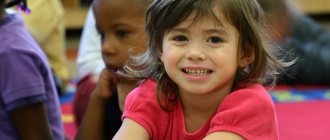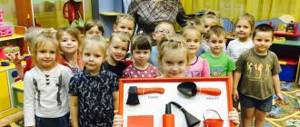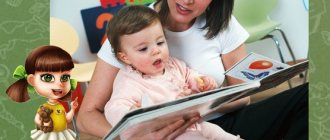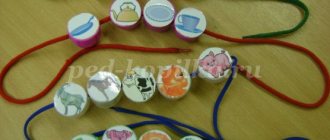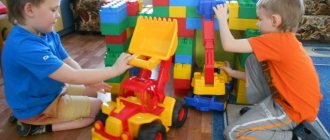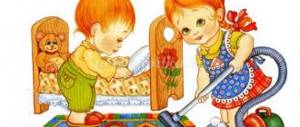January 25, 2020
“Your baby is already three and not yet in kindergarten? Horrible! Use every opportunity to get a place, otherwise your child will not be socialized!” Not...what? What is child socialization? How and where does it happen? The role of kindergarten in the socialization of preschool children. We are discussing these and other questions right now.
The term “socialization” itself did not appear today, but it came into common use not so long ago. The older generation did not even think about this topic. Children were simply “taken” to kindergarten, since their parents and grandparents worked (they could have been imprisoned for parasitism), and leaving a child homeless even then was dangerous. Now the situation has changed. The article for parasitism has disappeared. Unemployment arose, many mothers had the opportunity to stay at home with their children not for two months, but for as long as they wanted - the entire preschool, and sometimes school age. And if previously all the children of the country were brought up in the same spirit, according to the orders of the party and government, absorbing social values, now options are possible. For children at home, the value system is formed under the influence of the family and may differ from the generally accepted one. Is it good or bad? It all depends on the people surrounding the child. It is under their influence that the little man’s socialization occurs—his entry into society.
Socialization - what is it?
It turns out that the term “socialization” still does not have an unambiguous interpretation. Here are a few definitions and statements.
Great Soviet Encyclopedia: “Socialization is the process of assimilation by a human individual of a certain system of knowledge, norms and values that allow him to function as a full member of society.”
Freudians consider socialization to be merely the adaptation of innate forms of behavior to the conditions of existence in society. Freud said that every person is driven by reflexes and desires (the unconscious). Faced with the norms of behavior in society, the guide of which are primarily parents, a person is formed as an individual, finding his place in society.
Marxists argued that socialization is the process of forming an integral personality, as a result of which each person can express his individuality, fully overcoming outdated norms and bad habits and becoming an active member of society - the creator of his own life. Marx and Engels wrote: “Just as society itself produces man as man, so man produces society.”
Symbolic interactionism, represented by J. Mead, defined socialization as “the process in which a person tries on different social roles and finds his Self.”
Vygotsky Lev Semyonovich , a Soviet psychologist who wrote many articles on raising children and personality development, distinguished several stages of socialization:
- psychogenetic (early) - development of habitual patterns of satisfying one’s needs;
- figurative-symbolic (medium) - the connection of habitual actions with generally accepted signs, symbols and sounds;
- intellectual-conceptual (highest) - managing oneself and others with the help of learned signs, symbols and sounds, acquiring new skills.
Erik Erikson , an American psychologist, came to the conclusion that socialization is a process that lasts a lifetime and can be corrected even without the desire of the person himself, just by the conditions in which he is placed and to which his inner self is directed.
S.Yu. Golovin in his “Dictionary of a Practicing Psychologist” writes that socialization is the process of assimilation and active reproduction of a system of social roles that are realized in any communication and any activity. A person absorbs social norms, skills, stereotypes, attitudes and the accepted value system.
In the Big Psychological Dictionary, edited by academician. V.P. Zinchenko and B.G. Meshcheryakov can be read that socialization is the process of developing self-regulation, the formation of self-awareness and an active life position, which is controlled first by the family, then by groups (preschool, school, work). Socialization is based on joint socially significant activities during which a person becomes an individual.
S.S. Stepanov in the Popular Psychological Encyclopedia quotes the words of Anatoly Viktorovich Mudrik, a Soviet scientist who studied the issues of upbringing and socialization of children. He defined socialization as the process of formation and change of a person as a result of his awareness and experience of the reality in which he lives, his place in it and himself.
Based on the above statements, we can generalize.
Socialization:
- impossible without communication;
- a continuous process that lasts a lifetime;
- has stages;
- depends on the person’s environment;
- helps you find your place in society and survive in it;
- shapes a person’s life position.
What is the process of socialization of preschool children?
Socialization of preschool children is the foundation for the younger generation’s successful entry into later life, at school, in educational institutions, at work and in personal relationships. At this age, the most valuable communication skills and the foundations for understanding one’s own place in life and society are laid. Children learn norms and motives of behavior, concepts of values that correspond to the society in which they grow up. A connection is established between the main spheres of children’s existence and their psyche, which also affects the development of the psyche.
The process of socialization begins literally from the first months of a child’s life, when the baby begins to distinguish people caring for him from inanimate objects, loved ones from strangers, reaches out his hands to an object that interests him, gives a voice not just out of discomfort, but wanting to attract attention, responding to gestures and facial expressions of relatives.
Lack of socialization entails a wide variety of negative consequences for the individual, which are all the more difficult to overcome, the more that was missed in the early stages of development. This affects not only the lack of awareness of children about the correctness of behavior, but also threatens the wrong orientation of personality development and problems in the emotional sphere.
The child's psyche is plastic enough to compensate for some shortcomings in timely completion of the stages of entry into society, but one cannot completely rely on this. Each child has his own personal characteristics and capabilities, and there is no point in risking that the child himself will not be able to cope with certain difficulties of this process.
Types of socialization
Modern scientists no longer talk about socialization in general, but that there are several types of it, each of which is determined by specific age, living and other conditions.
- Primary - begins from the moment of birth of a child, occurs in the family and is the basis for other types.
- Group - one that occurs under the influence of a specific social group (kindergarten, for example). If a child spends more time in a group than with his parents, then the main social values will be group values, and family values will be leveled out, which can lead to conflicts in the family due to misunderstanding and significant differences in vital guidelines.
- Gender begins as soon as a person realizes that he belongs to a certain gender. It is very important for a girl to grow into a woman, and a boy to grow into a man. If an authoritative adult with free views appears next to a small child, then the guidelines may shift and sexual self-differentiation may be disrupted.
Summary of educational activities for socialization in the middle group “It’s so good to have friends”
Anna Shabaeva
Summary of educational activities for socialization in the middle group “It’s so good to have friends”
Summary of final direct educational activities on socialization in the middle group .
Topic: “It’s so good to have friends ”
Priority: “ Social and communicative development”
In the integration of educational areas: “Speech development”
,
“Cognitive development”
,
“Safety”
.
Formation of an emotional – positive attitude towards close friends .
-Identify children’s knowledge about professions: salesman, doctor, driver, conductor, postman; what material are the objects made of? about the activities of adults; on norms and rules of behavior in public places; differentiated ideas about transport as a means of transportation , about vegetables and fruits.
Develop the ability to reason, compare and draw conclusions, develop memory, imagination, logical thinking.
Teach children the rules of etiquette in public places; promote the manifestation of attention and care towards other people.
Vocabulary work: activate children's vocabulary in words of greeting and farewell.
Preliminary work: Learning poems, songs about friendship, the game “Shop”
,
“Hospital”
,
“Bus”
,
“Family”
.
Materials and equipment: chairs according to the number of children with pasted drawings, cards - drawings - tickets; "Shop"
toys and vegetables, fruits; toy ; letter, traffic light, pedestrian crossing.
(Children enter to the music “Strong Friendship...”
, stand in a semicircle.)
All the children gathered in a circle,
I am your friend and you are my friend.
Educator: Children, come to the table, there is a letter here. How do you think. Who brought him to us? ()
That's right, the postman.
Let's read what it says there. (the teacher reads the letter)
Educator: Children, our friend Mishutka is sick and is in the hospital. Children, what needs to be done so that he doesn’t get bored? (children's statements)
.
Educator: Let's visit him. The hospital is far away. How will we get there?
Q: Which one? (children name types of transport)
Q: Children, since the hospital is located in our city, I suggest going there by bus. Who drives the buses? (chauffeur)
Children, we need to take our place, to do this we need to get a ticket from the conductor.
B: Let's go. Children, we need to buy a gift for our Mishutka, but where can we get them? (in the shop)
.
At: Stop "Shop"
.
Children who work in the store? (seller)
Let's go out and buy a gift for Mishutka.
Only we have an unusual store, the seller will sell us what we want to buy if we describe the item. I will be the seller, and you will be the buyers.
Children, how should you behave in the store. ()
The right thing to do is to stand in line and take turns buying. Children come up to the counter and talk about the item they want to buy.
— I want to buy a cucumber, it’s an oval vegetable. Green colour.
-I want to buy a toy, a nesting doll, it is dressed in a colorful dress, it is made of wood.
Q: Children, you bought gifts for Mishutka, and did you remember to thank the seller?
Q: Children, the hospital is not far away, let’s continue on foot.
While we walk and rest a little.
Keep up with .
We need to cross the road, how to cross it without getting hit by a car? (children's statements)
Q: That's right, you need to cross it at the pedestrian crossing when the light is green.
Q: Children, we are approaching the hospital, let’s remember how to behave in the hospital. (children's statement)
Q: Who works at the hospital? (doctor)
B: Well done. Now we will ask him in which ward our little bear is lying.
The children ask the doctor in which ward Mishutka is lying.
Children come up to Mishutka, greet him, and ask how he feels? They give him a gift. Mishutka thanks them. He is so glad that friends visited him and he is sure to recover quickly. And the bear, as a token of gratitude, gives the children a coloring book. So that they don't forget about him.
“It’s so good that there is a mother in the world!” Sports entertainment Entertainment for Mother's Day, together with parents “It’s so good that there is a mother in the world!” Ved. : Everyone in the world loves mom, Mom is first.
Photo report “Dear mommy, my mom, how good it is that I have you!” Mom is such a short but meaningful word; in all languages of the world it sounds equally tender and affectionate. There are so many interesting ideas you can come across.
“It’s good that there are adults and children in the world!” Day of Knowledge in first grade Day of Knowledge “It’s good that there are adults and children in the world!” in 1st grade GOALS: 1. Fostering love and respect for loved ones: dad, mom, grandma.
Summary of direct educational activities for children of the younger group “It’s so good that there is a family...” Galina Filatova Purpose: Educational: to give children basic ideas about the family, its role in human life, expand and systematize.
Summary of the GCD “What is in my house?” on the cognitive and social-communicative development of children of the middle group Topic: “What is in my house” (dishes, furniture.) Purpose: To introduce the history of dishes (spoons, jugs, furniture (chairs, call them external.
Summary of educational activities for speech development in the second junior group “What is good and what is bad” Purpose of the lesson: talking with children about bad and good deeds, improve their dialogical speech. Objectives of the lesson: create conditions for...
GCD summary for speech development “What is good and what is bad” in the second junior group GCD summary (speech activity) “What is good and what is bad” in the second junior group Goal: To improve dialogic speech.
Lesson notes for the second junior group “It’s good to have friends” Lesson notes for the second junior group “It’s good to have friends!” author: Shashkova E. N. Objectives: - Foster a fair attitude.
Photo report about the project “Dear Mommy, my mom, how good it is that I have you!” in the second younger group Video Nowadays, when the upbringing and development of a child of preschool age is greatly negatively influenced by employment and detachment.
Mother's Day holiday in the preparatory group “It’s so good that there is a mother in the world.” Scenario for the holiday “Mother’s Day” in the preparatory school group “It’s so good that there is a mother in the world” Goal: to cultivate a feeling of love.
source
Social institutions
Social institutions are groups of people surrounding a person at one time or another in his life. There are quite a lot of them.
- The family is the most important “institution” of socialization, if the family is complete (do not confuse it with the concept of “complete” and an incomplete family can be absolutely complete). In the family, a child learns to interact with and manage others, recognizes his belonging to a certain gender, social class, absorbs family values and traditions, views on life, politics, “good and bad.” If the family does not care for the child or does little work (parents work all the time, there are no grandparents), then the child’s socialization occurs in another place, where he is cared for and where he spends more time.
- A peer group in a kindergarten, school, additional education system, interest group, etc. It ranks second after the family in terms of the strength of a child’s socialization.
- Education. A child can gain knowledge in a group or individually, but at the same time he still correlates the acquired knowledge with his social groups.
- Economy. Family wealth significantly influences a child’s socialization. If peers have Barbie dolls, for example, and a girl has them, it’s one story, but if everyone has them, but she doesn’t, it’s a completely different story. When moving to another kindergarten, it may turn out that mobile phones are held in high esteem there, and Barbie is boring. The child will have to adapt to a new value system.
- Language. If a child does not speak and does not understand speech well (migrant), then his socialization will be difficult, and he may become an outcast in the group.
- Religion. In a religious family, children grow up as adherents of the faith. Faith is a set of dogmas and laws that completely control human behavior in society. Socializing a child from a religious family can be difficult. Therefore, such parents need to choose a preschool institution more carefully.
- Mass media. Preschoolers are more influenced by television. If parents do not control the viewing of television programs, then the baby can learn a lot of unnecessary things, things that will shape his outlook on life and his socialization in a completely different form than the parents wanted.
- Legal system. Children learn to obey certain laws in families and groups. Unfortunately, if people from the child’s close circle have been or are in prison, then the child does not have any fear of the punishment system; they are logically integrated into his value system. Such children, growing up, are more likely to commit acts that are contrary to the law, those for which they can even be subject to criminal punishment.
Gender socialization of children of primary preschool age
Dear friends, we are pleased to introduce you to Viktoria Aleksandrovna Romanenko, teacher at State Budgetary Educational Institution Secondary School No. 19 SP DS “Golden Key”, Novokuibyshevsk, Samara Region. Today Victoria Alexandrovna is pleased to bring to your attention an article about the gender socialization of children of primary preschool age. This material will be of interest to parents and teachers of preschool educational institutions.
Brief commentary on the article from Victoria Alexandrovna:
“Taking into account the principle of a differentiated approach, in this work I consider it advisable to implement this approach by dividing the general group of children into two subgroups, different by gender, in conditions of joint education of girls and boys in a preschool educational institution. Moreover, girls and boys are not isolated from each other, but in natural conditions, in the process of joint activities, they can accumulate experience in communicating with the opposite sex. Here it is necessary to take into account the characteristics of each girl and each boy - that is, to implement the principle of an individual approach to each child.”
Interesting reading...
Gender socialization of children of primary preschool age
(implementation of the educational field “Socialization”)
The modern system of preschool education, comprehensive programs for the upbringing, education and development of preschool children are built without an emphasis on gender, where there is only a child of a certain age with general development standards for both girls and boys. Awareness of gender influences the formation of the psyche, emotional balance and well-being of a person.
In recent years, significant changes have been taking place in the preschool education system. One of the significant documents is the Federal state requirements for the structure of the basic general education program of preschool education, which spells out the content of the educational field “Socialization” and is aimed at achieving the goals of mastering initial ideas of a social nature, including children in the system of social relations through the formation of gender... belonging to the world community.
The fact has been revealed that in preschool educational institutions there is a disconnect between girls and boys. At the age of 3 to 7 years, children have 91% of selective contacts and 9% with children of the opposite sex.
I set myself the following tasks:
- Finding ways to promote friendship and interaction between girls and boys.
- Create conditions conducive to gender socialization of children.
Therefore, from the younger group I began to carry out work on gender socialization of children.
A child from 3 to 4 distinguishes the gender of the people around him, but continues to associate it with such random signs as clothing and hairstyle. Makes attempts, without the help of adults, to divide roles in games in accordance with the gender of the participants in the game.
Boys begin to show initiative, activity, and competition. Interests and value orientations and preferences for certain types of activities and modes of behavior characteristic of boys and girls begin to take shape, the first ideas about the social roles of father and mother appear in the role-playing game “Family”. If a girl doesn’t have a penchant for playing in the kitchen or pushing a stroller, but a boy doesn’t have a penchant for playing with cars, I try to figure out why this is happening, but in no way do I reproach for it or ban my favorite cars or dolls. It is dangerous not for a boy to play with dolls, but to demonstratively take away his doll and ridicule him for playing with girls. The child must communicate with the opposite sex and be able to understand him, and this, again, is easier to do through play.
Children of both sexes participate in games that reflect the interesting, rich life of the family. With my children I play the following games: “Family on a camping trip”, “Waiting for guests”, “Let’s go for a visit”, “A baby is born”, “Doll’s birthday”, “The doll is sick. Calling an ambulance", "Hairdressing salon", "Let's comb the doll", "Car repair shop".
Children become interested in their bodies, and the children and I look at the doll, note what it has, and conduct educational games “Let’s dress the doll for a walk,” “Let’s put the doll Katya and Petya to sleep,” “Let’s feed our dolls,” etc.
During the most crucial period in the formation of gender stability, girls and boys are exposed exclusively to female influence for a long time in a preschool educational institution (8-12 hours).
Observations show that at present, educators’ address is limited to the word “children,” which does not contribute to the identification of the child’s self-image with a certain social role. Therefore, I try, when it is appropriate, to address my children individually by name and emphasize the significance of the child’s action: “Well done, Slava, what a strong boy you are, you helped Sveta carry the chair,” or “Olechka is a neat girl, she folded it neatly.” your clothes...
The teacher needs to remember that girls are extremely sensitive to intonation, to the form of assessment, and its publicity. It is very important for girls to be admired in the presence of other children, parents, etc. For boys, the most significant is the indication that he has achieved results in this very area: he has learned to say hello, brush his teeth, design something, etc.
Observing the play activities of children, I noted different content and play styles, which often cannot be realized by children due to the fact that we, female educators, are closer to girls’ quiet games on family and everyday topics. Boys' noisy, action-filled games irritate many teachers, as they believe that this kind of play is just pointless running around and can lead to injury, and, therefore, they have no place in the life of the group and should be stopped. As a result, boys are deprived of truly “manly games,” which negatively affects their personal development.
Therefore, when raising boys and girls together, I think that a very important pedagogical task is to overcome the disunity between them and organize joint games, during which children could act together, but in accordance with gender characteristics.
I try to work with children thematically, using all life situations and specially prepared:
- thematic week “Water” direct educational activity “Let’s paint the water in the aquarium” - we looked at a picture of an aquarium, then I suggested choosing a paint color, instructing the boys to paint the water with green paint - a lot of algae, and the girls with yellow paint, a lot of sand. At the end, while listening to music, we played the game “Fish in an Aquarium” with the children (integration of the educational areas “Cognition”, “Socialization”, “Artistic Creativity”).
- theme week “Winter”, I came up with a game motivation that would encourage children to complete the following task: “Winter has come, the children will be sick, they need to be given vitamins. Let's learn how to make vitamins for bunnies. For girls - red, for boys - blue (children's choice)." Task: “treat the bunnies with vitamins,” “I will help you make vitamins for the bunnies.” Along the way, I carried out all the activities in a gaming context. For example: “I’m afraid that the bunny won’t be able to swallow such a large vitamin, what should I do?... At the end, the bunny mother comes, approaches each child and thanks him. In addition to assessing the results of the children’s activities, the bunny mother gives the children direction for further play activities, taking into account gender characteristics (asks the children to take the bunnies for a ride on a bus built from cubes, to feed them);
- I conduct joint games with different game situations: “Hens and a cockerel”, “Duck and ducklings”, “Who wears what”, “Who does what”...
Reading fiction has a beneficial effect on the gender socialization of students. A fairy tale is a natural way of communicating with children. It is always full of social actions and a moral basis. They teach and create an emotional positive model of gender behavior. With the help of fairy tales, it is possible to identify existing false stereotypes of behavior, which allows you to plan correctional work, in which it is necessary to show equal social opportunities for girls and boys. I try to read a wide variety of fairy tales to girls and boys. In terms of gender, I conditionally propose to divide fairy tales into three groups:
- “male”, reflect male behavioral strategies, where the main character is a male character;
- “feminine”, reflect female strategies of behavior, where the main character is a female character;
- “mixed”: there are two main characters of both sexes, which tells about the relationship and mutual influence of masculinity and femininity and their harmonization. Awareness of oneself as a man or woman is the precursor to a harmonious union.
For example, fairy tales for boys - “The Three Little Pigs”, “Kolobok”. After reading a fairy tale, I talk with the children about the behavior of the characters in different situations. In the process of developing and raising boys, I show boys as many “masculine” models of behavior as possible. Everything that a boy remembers in childhood leaves an imprint on his adult life.
And the most popular women's fairy tales are “Little Red Riding Hood”, “Masha and the Bear”, “Little Khavroshechka”, “Cinderella”, “Morozko”, etc. All “women’s” fairy tales help a girl to comprehend the meaning of femininity and secrets, variations in relationships with a man; a woman’s ability to create a comfortable environment around herself, where she would feel protected, and be able to accept help.
Problems related to the organization of the subject-spatial environment require special attention from teachers. The subject-spatial environment not only provides different types of activity for preschoolers (physical, play, mental, etc.), but is also the basis for their independent activity, taking into account gender characteristics. In our group, we tried to think about how and where to arrange the attributes for games, in the sleeping group - bedspreads of different colors, in the washroom - we selected two colors of towels for wiping hands in the locker room on the lockers - differentiated labels for girls and boys; We decided to arrange the tables in the group by color.
The interaction with parents was great. I had conversations with them on the topics: “On the upbringing of girls and boys”, on the importance of the “mother’s image” and “father’s image” in the emergence of gender-role stereotypes of behavior in preschool children, prepared consultations: “recommendations for raising boys and girls in the family” , “What are our boys and girls made of”, “The role of the father in raising children”, “How and what do boys and girls play”, developed reminders: “Teach a boy to be a boy, and a girl to be a girl”, “Girls and boys - how different they are”, “Tips for raising a boy”, “Tips for raising a girl”, “Features of games for boys and girls”.
Work to create conditions in kindergarten that promote gender socialization of children has brought positive results. The level of psychological and pedagogical competence of educators has increased and their creative potential has grown. A survey of parents helped to find out that 55% acquired knowledge about the characteristics of raising children of different genders, 25% reconsidered their views on raising children of different genders. Thanks to educational work on gender education, 26% of children of primary preschool age in our preschool educational institution have some differentiated ideas about their own gender belonging, 19% of children try to master certain methods of action that dominate the behavior of adults of the corresponding gender.
In my work I used the following resources:
- Adler A. Raising children; interaction of the sexes. - Rostov-on-Don, 1998. - 124 p.
- Babunova T.M. Preschool pedagogy: Textbook. — Publisher: “TC Sfera”, 2007. — 208 p.
- Doronova T.N. Girls and boys 3-4 years old in family and kindergarten: A manual for preschool educational institutions. - M.: Linka - Press, 2009. - 132 p.
- Eremeeva V.D. Boys and girls: Teach differently, love differently. - Publisher: "Educational Literature", 2008. - 160 p.
- Efremova V.D., Khrizman T.P. Boys and girls are two different worlds. Neuropsychology - teachers, educators, school psychologists. - M.: LINKA - PRESS, 1998. - 138 p.
- Mikhailenko N.Ya. Organizing a story-based game in kindergarten: A manual for teachers. - Publisher: Linka-Press, 2009. - 96 p.
- Mukhina V. S. Age psychology. M., 1997. – 230 p.
- Shelukhina I.P. Boys and girls: A differentiated approach to raising preschool children. — Publisher: “TC Sfera”, 2008. — 96 p.
- Shchetinina A.M. Gender-role development of children 3-7 years old: Methodological manual. — Publisher: “TC Sfera”, 2010. — 128 p.
https://nsportal.ru/detskii-sad/raznoe/gendernoe-vospitatnie-doshkolnikov
A few more important terms
Social neglect is a child’s social feelings, interests, skills and abilities that are not properly formed. As an example of the extreme degree of social neglect, one can recall the Mowgli children - those who were raised by animals. Found at different ages and returned to human society, for a long time they continued to behave as they would in an animal foster family. They did not know how to talk, dress, sit at the table, eat with cutlery, wash, etc. If social neglect is detected early, it can be corrected and the person can be returned to normal life in society. If it’s late, it’s difficult to do it.
Social maladaptation is a person’s violation of the norms of morality and law, value orientations and life attitudes established in society. For example, if a child grows up in a family where everyone smokes, swears and takes food from each other, then he will behave this way in kindergarten - he just doesn’t know how to do it any other way. Social maladjustment can be corrected, especially easily in preschool age.
Resocialization is the elimination of a previously established behavior model, replacing it with a new one. For example, a child goes from an orphanage to a family. His behavior pattern changes radically, and resocialization occurs. Resocialization of children also occurs in kindergartens, especially sharply if the value system in them differs from the family one. For example, everyone in the family speaks calmly, but the teacher likes to raise his voice. In the family, the child’s needs are immediately met, and in kindergarten - on a first-come, first-served basis. The baby has to get used to the new routine.
Early socialization is an interesting phenomenon that has developed historically and helps a person quickly adapt to new living conditions and act correctly. For example, girls play with dolls, preparing to become mothers.
Desocialization is a person’s loss of social experience. Preschoolers may leave their families for orphanages or hospitals and lose communication and self-care skills. If a small child ends up in a foreign-language family, he stops speaking his native language. Nowadays, desocialization in children is caused by excessive passion for computer games, when the child prefers activities with electronic devices to communicating with real people.
Important takeaways:
- a child is well socialized when there are adults nearby who are interested in him, who teach him the rules of behavior in different situations, norms, laws and etiquette, self-service, help and mutual assistance, a culture of communication;
- The child’s socialization suffers if he finds himself in isolation, if he is not cared for, if he finds himself in a world that lives according to a different scale of values.
Possible problems and their solutions
The process of socialization of preschool children cannot proceed without problems, even if the children belong to relatively prosperous families. This is due to the fact that they grow up in the adult world with its difficulties and upheavals, lack of money and time from parents, and the inability of adults to delve into the intricacies of child psychology in general and even their own child in particular.
Among the most common problems in the socialization of preschool children are:
- The discrepancy between the goals and desires of the child and the goals and desires of the adults involved in his upbringing. The child - naturally - wants to play and have fun, adults strive to aim him at preparing for adulthood, entering school, achieving success in sports, targeted training, etc. To resolve this conflict, it is important to maintain a balance between real benefits and psycho-intellectual capabilities inherent in childhood. There cannot be a clearly laid out path, but requires attention and flexibility on the part of adults.
- Lack of attention and activity. This is especially true for children with poor health who have experienced or are exposed to stress. When working with such children, patience and sensitivity, tireless and gentle progress in establishing contact and developing the child’s interest in the world and entering society are especially important.
- Inability to determine desires and make decisions. This largely stems from a lack of life experience, but it can also be determined by the conditions in which children are raised. In kindergarten and at home, teachers (and the educational program), parents, and sometimes older or simply more developed and lively children decide for them. And it is easy for a child to succumb to this influence, because it allows him not to face difficulties of an intellectual and ethical nature. And even doing the right thing on someone else’s command, such a child remains insufficiently mature emotionally and psychologically, since the deficiency of the mind and soul negatively affects his development as an individual and a member of society. And it is very important to be attentive and sensitive to the manifestations of children’s emotions, to give more freedom to their initiative, not only to teach givens, but also to develop an understanding of causal relationships, thinking and activity.
Socialization of preschoolers
Now that we have thoroughly understood what socialization is, how it occurs and how it is lost, we can talk about the socialization of preschoolers and who needs to attend kindergarten.
The state is paying more and more attention to issues of socialization, as it has become clear that without certain values, society loses its spiritual and moral guidelines. The main awareness of one's own self and society as a whole occurs by the age of 6, so preschool education comes to the fore. The requirements for it are becoming more stringent. It is planned that all children will be enrolled in preschool education in the very near future. By and large, this is good, because it is in kindergarten (we are talking about a good preschool!):
- children become familiar with cause-and-effect patterns;
- understand the place of each person in life;
- are aware of the roles the people around them play;
- meet many people from different professions;
- learn about new games, concepts, laws and patterns;
- understands what he likes to do;
- becomes familiar with the rules of ethics and morality.
The child learns:
- feel social distances and space, take the correct place in the team;
- control your emotions and express them correctly;
- learn to find a way out of difficult situations that are modeled by the teacher for educational purposes;
- try on everyday and professional roles;
- get acquainted with the elements of adult life.
Is it possible to give all this in the family? Yes, sure! Especially if the child is not the only one and is not confined within four walls, but actively communicates with peers in the yard, in developmental classes, has the opportunity to satisfy his curiosity and build relationships with a variety of people.
Kindergarten problems
Everything would be perfect if it weren’t for the notorious human factor. There are developed programs and methods. They are really good and help to unlock the potential of every child. However, they operate only where passionate professionals work. In this case, children run to kindergarten with pleasure, and parents rejoice at their rapid development and emerging good and versatile skills and abilities. Unfortunately, this is not always the case. And then problems arise: children do not want to go to kindergarten, they cry, their character deteriorates, and not the most pleasant habits appear. For example, children begin to bite, push, and offend younger ones. This is incorrect socialization and the reason is the microclimate of the kindergarten. Having seen something wrong, parents should not let the situation take its course. It is imperative to figure it out and do everything possible to ensure that the child is in comfortable conditions and his neuropsychic development does not suffer.
Conclusion: kindergarten can provide both socialization of the child and his desocialization with a non-professional approach.
